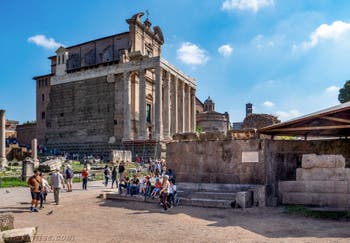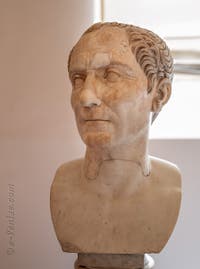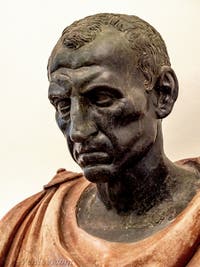Roman Forum Art Story | Location | Opening Hours Tickets | Authorisations
Art Story Mythical Place | Temples Vestals
The Roman Forum, the Mythical Place of Ancient Rome in Italy
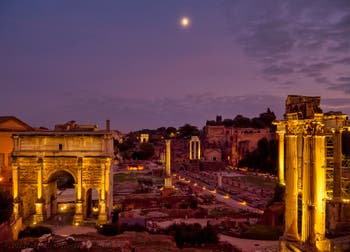
Septimius Severus Arch Concord Temple It is a virtually magical and truly impressive place.
When you walk through the aisles of the Forum one cannot help but feel the past greatness of Rome, one feels so small in the midst of all these remains, works of art and temples, most of which are twice millennia.
Some of these places, such as the Temple and House of the Vestals or the Temple of Caesar, are also moving.
Finally, the climb to Mount Palatine, the tour of which is included in your entrance ticket will give you a superb, unique and complete view of the Forum, but also of Rome nearby.
The Roman Forum: a Village Square
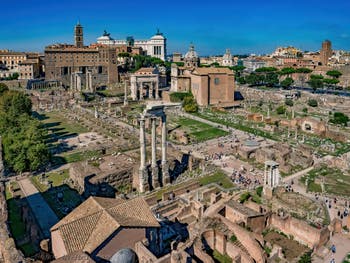
Roman Forum seen from the Palatine Mount The Roman Forum is the ancestor of the village square.
It is located in a flat area between the Palatine and Capitol hills and the slopes of the Quirinal and Viminal.
This land between these hills was flat because it was a marshy area that collected rains from the surrounding mountains.
But because of its perfect position between the various primitive dwelling areas of Rome, shepherds, peasants and merchants still came there to meet and sell their products.
This valley also served as a burial place.
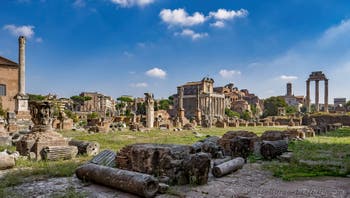
The Roman Forum in Rome in Italy In doing excavations, a necropolis dating from the foundation of Rome was found buried under the Forum.
So many events in the early history of Rome have happened here!
Romulus met there with Tito Tazio, with whom he shared the throne of Rome.
The alliance covenants were also concluded at the Forum, and it seems that the famous Sabine abduction would have taken place there.
The Roman Forum, a simple marketplace that has become the heart of Roman life
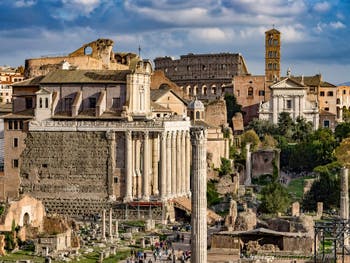
Roman Forum, Antoninus Faustina Temple With the expansion of the city, this village marketplace gradually transformed into a larger commercial area with real shops.
There were various and varied shops: sales of spices and herbs, meats, fabrics, jewellery, etc., but also bankers, an essential element for the trade.
Since the Forum became an important centre for trade and business in Rome, towards the end of the 7th century BC it was decided to dry up this area with stagnant waters by installing a system of underground disposal of waters: the “Cloaca Maxima”.
Rainwater and the Forum swamp were thus discharged directly into the Tiber River.
To dry the place perfectly and compensate for the risk of moisture, the Romans covered the entire surface of the Forum with five metres of sand.
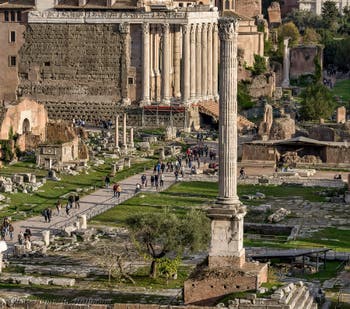
The Foca Column in the Roman Forum In addition, the Roman Forum had been paved, as early as the 7th century BC.
Subsequently, the Forum also became the place where the government met, where decisions were made, voted, enlisted to go to war, come for enumeration, justice, and religious ceremonies began.
The real place, as we know it, in our cities: shops, church, town hall, banks, etc.
The “Comitium” was the central part of the Forum reserved for the elections of judges, political discussions, the posting of notices, the most important religious holidays, public games and all the ceremonies that directly related to the life of the City.
The “Comitium” area is clearly identifiable at the centre of the current Forum.
An official building, the “Curia”, was then built right next to the “Comitium”, to accommodate meetings of the Roman Senate.
The Roman Forum had then become the true heart of Rome.
The Basilicas of the Roman Forum
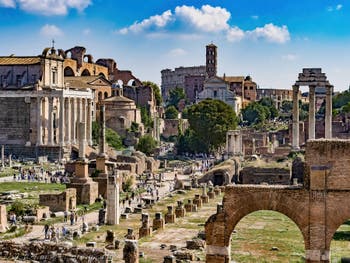
The Roman Forum Temples and ruins All the ceremonies, discussions and celebrations were first in the open air. Subsequently, brick huts were specially built to accommodate them: the “Tabernae”.
Then, given the growing importance of this vital centre of Rome, during the second century BC the construction of the great basilicas of the Forum began.
These were used for public announcements, commercial transactions, but also as courts.
It should be remembered in this respect that the Latin term “Basilica” meaning “tribunal” comes from the Greek “Basilikê” which meant “royal”.
But architecturally, the basilica is a Roman invention.
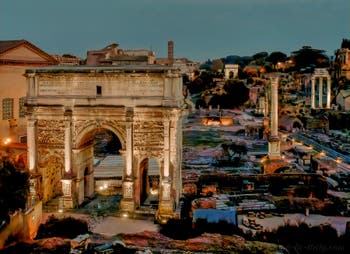
The Roman Forum by night For the Romans, they were large covered buildings, illuminated by windows at the top of a higher central nave, while the interior was divided by colonnades.
These basilicas were not only closed, but also surrounded by long porticoes.
They always had two floors and the main entrance to the building was on the longest side, unlike the Christian basilicas where the entrance is on the shortest side.
Moreover, while for Christians, the meeting place is located inside the basilica, among the Romans, they met outside the basilica.
Finally, while the basilica became a religious place par excellence for Christians, it had no religious character for the Romans who, to do so, had temples corresponding to each of the deities they honoured.
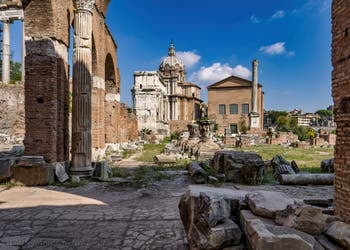
The Roman Forum Temples and ruins Similarly, unlike Christians, in Roman temples, priests were most often inside temples while the faithful stood outside.
Among the great basilicas of the Forum is the Emilian Basilica, built in 197 BC and paid for by the Emilian family, hence its name, one of the richest and most powerful families in Rome at that time.
When all these basilicas were built, the Emilian, but also the Giulia, Porcia, Sempronia, many temples were raised, the sanctuary of Vesta, beavers, protectors of weapons, Saturn, Concord, Venus Cloacina, etc.
Roads were also built linking the Roman Forum directly to the neighbouring districts.
The Forum had become not only a monumental place, but also the heart of Rome's civil and political life.
Via Sacra, the sacred path of the Roman Forum
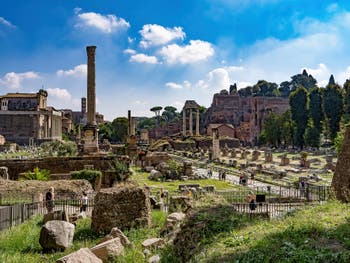
The Roman Forum with the Foca Column The main artery of the Forum was called the sacred way, the “Via Sacra”.
She crossed the Roman Forum along its entire length to climb up to the temple of Jupiter, at the top of the Capitol.
It should be noted that as such, the movement of carts and other vehicles of that time was prohibited within the Forum.
The aisles of the Forum were indeed teeming with people, a crowd far too dense to give way to any vehicle traffic.
All military and religious processions marched on Via Sacra, which begins just in front of the Colosseum to the Temple of Jupiter.
Along this Via Sacra, during the triumphal ceremonies of celebrations of victories, the barbarian kings captured during wars were exhibited, chained and humiliated before the Romans.
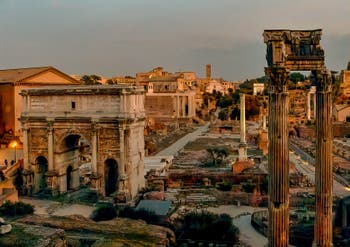
The Via Sacra by night In the year 46 BC, after the Gaul War, Vercingetorix was one of the prisoners humiliated in front of the crowd during Caesar's triumphant parade.
In addition to the victor and the prisoners, there were the legionaries who paraded with the reported loot of the war.
They passed first in front of different temples of Rome, then, after crossing Circus Maxime, they arrived at the Roman Forum, and paraded on Via Sacra passing by the Comitium and the Curia of the Senate.
The final stage of these triumphal parades was the temple of Jupiter Optimus Maximus, where the victorious general was lifted from the vow he had made in the same place before leaving for war.
In this way, the omens of the Gods, the auspices he had accepted from there to fight, found their confirmation.
The Roman Forum marked the point of departure and arrival of Rome's territorial expansion on the world.
Julius Caesar and the Roman Forum
Julius Caesar was also behind a plan for the restructuring and large-scale renovation of the Roman Forum.This monumental undertaking was continued and expanded upon by Emperor Augustus.
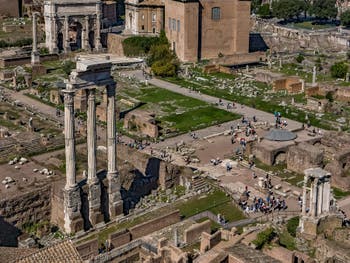
The Via Sacra and Jules Cesar Temple Of course, Julius Caesar could not have known that this same Forum would also be his tomb: after his assassination, his body was transported to the Forum where Emperor Mark Antony delivered his famous funeral oration, later quoted by William Shakespeare.
Next to the Sacred Way, in front of the Temple of the Dioskouros, a pyre was erected to burn his body and the veterans of Caesar's wars threw down their swords.
The Hebrews, whom Caesar had protected by granting them freedom of worship and exempting them from public duties that might conflict with their religious beliefs, also came to mourn around his corpse, dressed in mourning clothes.
Birth of the Living Gods in the Roman Forum
After celebrating Caesar's funeral, Augustus erected a commemorative column and a temple to ‘God Caesar’ on the very spot where his body had been burned.Unfortunately, little remains of this temple, which must have been majestic, except for a few pillars and walls.
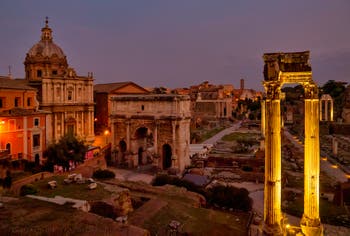
Roman Forum by night This was the first instance of posthumous deification of a Roman leader. The Temple of Caesar, located almost in the centre of the Forum, is still honoured by Romans today. In addition to 15 March, the anniversary of his death, it is not uncommon to see bouquets of flowers placed on what remains of the altar, at the very spot where his body was cremated. The emperors who succeeded Augustus continued in this vein, and not only for the dead, since they even began to deify the living.
A means of amplifying imperial domination through the creation of a sacred bond between the population and its emperor. Emperor Vespasian, who built the Colosseum and had a good sense of humour, declared on his deathbed: ‘I feel I am becoming a god!’
Delusions of grandeur were becoming the norm in Rome, and among Augustus' successors, monumental equestrian statues of the emperors as ‘divine’ beings began to appear during their lifetimes.
The funeral of Julius Caesar, as recounted by Suetonius.
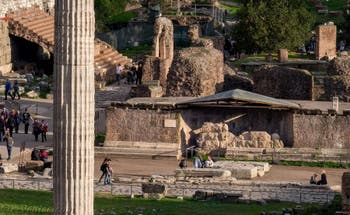
Caesar's temple Suetonius, in his work ‘The Twelve Caesars’, recounts the funeral of Julius Caesar and the emotion felt by the Roman people.
“On the day of his funeral, a pyre was erected in the Field of Mars, near Julie's tomb, and a golden chapel opposite the tribune, modelled on the Temple of Venus Mater.
An ivory bed was placed there, covered with gold and purple cloth, surmounted by a trophy of arms and the toga he wore at the time of his death.
As it was not believed that the day would be long enough to allow the crowd of those bringing gifts for the pyre, if the rules of the funeral procession were observed, it was declared that everyone would go without order, and by whatever route they pleased, to carry their gifts to the Field of Mars.
Caesar's temple The funeral rites were an opportunity to sing moving and indignant songs, such as Ajax's monologue in Pacuvius' play entitled ‘The Arms of Achilles’:
‘Was I their saviour only to be their victim?’
Instead of a eulogy, Consul Antony had a herald read the latest ‘Senatus Consulte’ which had awarded Caesar all divine and human honours, as well as the oath by which everyone pledged to defend him at the cost of their own lives.
Magistrates then carried the ceremonial bed to the public square.
Some wanted to burn his body in the sanctuary of Jupiter, while others proposed doing so in the Senate.
Bust of Julius Caesar Suddenly, two men armed with swords and carrying two javelins set fire to the bed with torches.
Immediately, everyone rushed to throw dry wood, benches, judges' seats and anything else they could find onto the fire.
Flute players and histrions threw in the triumphal robes they had worn for the ceremony, veteran legionnaires threw in the weapons they had adorned themselves with for their General's funeral, women threw in their ornaments and those of their children.
Foreigners took part in this public mourning and circled the pyre, expressing their grief, each in the manner of their own country.
The Jews kept vigil for several nights beside his ashes.
Bust of Julius Caesar The people, immediately after the funeral, gathered with torches in front of the houses of Brutus and Cassius, and were only driven away with difficulty.
The crowd then encountered a certain Helvius Cinna, whom they mistook for the tribune Cornelius Cinna, who had delivered a violent speech against Caesar the day before. He was massacred and his head was carried on the end of a pike.
Subsequently, a twenty-foot-high column of African marble was erected in the public square with the inscription: ‘To the Father of the Nation’.
For a long time, the people went there to offer sacrifices, make vows, and settle certain disputes by swearing by Caesar's name.
Julius Caesar died at the age of fifty-six.
Bust of Julius Caesar His divine status was not only recognised by religious rituals, but was also deeply ingrained in the minds of the people. During the games that his heir Augustus held to celebrate his apotheosis, a comet with a tail shone for seven days: it appeared around the eleventh hour of the day (five o'clock in the evening), and it was believed to be Caesar's soul being welcomed into heaven.
This is why he is always depicted with a star above his head.
The Senate chamber where he had been killed was walled up.
The ‘Ides of March’ (a festive day dedicated to the god Mars) were called the ‘parricidal days’. It was then forbidden to assemble the Senate on that day.
None of his assassins survived him for more than three years, and none died a natural death. All were condemned, all perished, each in a different way, some in combat, others in a shipwreck, several killed themselves with the same sword they had used to strike Caesar.”
Suetonius - The Twelve Caesars
Loss of the Forum's role as a political centre
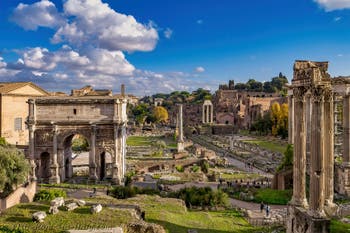
Septimius Severus Triumphal Arch With the development of the Roman Empire, the Forum began to lose its role as the centre of political power, which was now exercised on the Palatine Hill where, starting with Augustus, the emperors set up their villas and offices, which you can also visit.
But this did not mean the end of the Forum's importance, quite the contrary. At the same time, the commercial activities of the Forum were moved to other areas of Rome, including the Imperial Forums, the “Fori Imperiali”.
Only the money changers were allowed to continue their banking activities in the Forum.
From a commercial and political centre, the Forum gradually transformed into a sacred area symbolising the grandeur of Rome.
New temples and basilicas were built, while all the buildings in the Forum also became more luxurious.
Art Story Mythical Place | Temples Vestals
Roman Forum Art Story | Location | Opening Hours Tickets | Authorisations
Back to Top of Page


